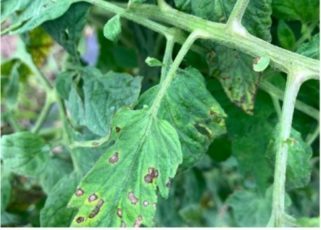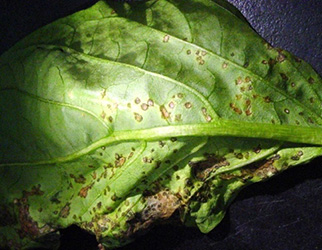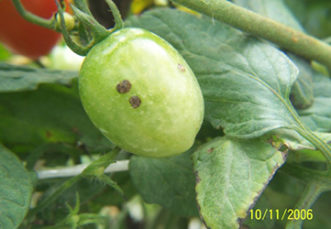Growers in the southeastern United States often have problems with bacterial spot on tomato and pepper. Although four species of the Xanthomonas bacterium are involved, in most areas, X. perforans is the most common species on tomato, and X. euvesicatoria is the most common species on pepper.1,2
Introduction
Bacterial spot mainly damages leaves. Many small, dark spots appear first on older leaves at the base of the plant. Spaces in between spots may turn yellow (figure 1). Spots quickly spread to blight and kill leaves. Dead leaves usually stay on tomato plants, but pepper plants drop severely diseased leaves. Leaf spots often can be seen on both the top and the bottom of leaves (figure 2). Green fruit on tomato and pepper may be spotted or scabbed (figure 3). Once tomato fruit begin to turn red and the acid content increases, fruit can no longer be infected.
Bacteria may be present on seed, on transplants, and on debris from a previously diseased crop. Wind, rain, and humans can spread bacteria from plant to plant. Blowing sand grains that injure leaves can give the bacteria easy entry points.
Integrated Control
To control bacterial spot on tomato and pepper, growers must use an integrated approach that combines resistant varieties, cultural practices, and chemical control. For best results, do not rely on chemical control alone.
Resistant Varieties
All tomato varieties are susceptible to bacterial spot.
For pepper, resistant varieties are the best control measure. Resistant varieties are the most cost-effective option with the least environmental impact. Resistance works against Xanthomonas euvesicatoria and Xanthomonas vesicatoria, the two most common species on pepper in the South. Choose bell pepper varieties that are resistant to all ten races of Xanthomonas euvesicatoria (races are genetic variants that infect partially resistant varieties).
- As of 2022, five pepper cultivars recommended for the southeastern United States have complete resistance to bacterial spot: Antebellum, Green Machine, Ninja S10, Prowler, PS 09942815, and PS 09979325. See the Southeastern U.S. Vegetable Crop Handbook.3
- Pepper varieties with complete resistance do not need to be sprayed for bacterial spot. All other pepper varieties must be sprayed (table 1).
Cultural Practices
Crop Rotation
Rotate fields out of tomato and pepper for twelve months before planting either crop again. This “rest” period allows crop debris that carries bacteria to decay, which kills the pathogen.
Cleanup (Sanitation)
- Promptly destroy crops after the last harvest to stop bacteria from multiplying in and on plants left in abandoned fields.
- Destroy spring crops before transplanting a fall crop on the same farm, so bacteria do not spread from one crop to the next.
- Do not replant into plastic or organic mulch used for a previous crop. Enough crop debris is left on or in the mulch to carry over the bacteria from crop to crop.
Row and Plant Spacing
The longer the leaves are wet, the greater the risk of bacterial spot. Leaves dry faster after dew or rain when there is more space between rows and extra space between plants in rows. This helps reduce the severity of bacterial spot.
- Space rows eight to twelve feet apart for tomato and eight feet apart for pepper.
- Leave a minimum of twenty-four inches between tomato plants and eighteen inches between pepper plants. Increasing the spacing between plants by six inches, if economical, is better.
Handling Plants
As most growers know, it is easy to spread bacteria when workers handle wet plants. Sucker, stake, tie, and harvest plants only when they have dried after dew or rain.
Chemical Control
The four programs in table 1 reduced severity of bacterial spot on tomato in two studies done at the University of Florida over several years.4,5
- No products have curative activity; all chemical control programs must be started before bacterial spot symptoms can be seen.
- Begin spray applications two weeks after transplanting in the spring and one week after transplanting in the fall.
- Spray on a weekly schedule.
- Use copper at the highest labeled rate. Do not mix copper with Actigard® due to phytotoxicity of the mixture.
On fruiting vegetables, Actigard® has a 14-day Pre-Harvest Interval (PHI), Mancozeb® has a 7-day PHI, and Tanos® has a 3-day PHI. To make scheduling harvests easier, use Tanos® + copper weekly after harvesting starts.
Cautions
Bacterial spot can reduce yields of tomato by 7% to 15%. Actigard® alternated with copper + Mancozeb® is the spray program that most consistently reduces bacterial spot on tomato. However, foliar sprays of Actigard® every other week can reduce tomato yields by 3% to 17%, so improved control does not necessarily increase yields.6,7 Growers should assess whether the cost and labor of spraying for bacterial spot increases net profits on their farms.
Organic Production
Organic growers should follow the recommendations for resistant varieties and cultural practices given above with the following note. Certified organic growers are required to use certified organic seed unless certified seed is not available for a specific variety. In this case, certified organic growers may use non-treated seed with permission from the certifier.
Serenade® plus copper (table 1) is an approved organic treatment, as long as the certifier allows preventative treatments with copper and an organic-approved formulation of fixed copper is used. Several different copper products are approved by OMRI (Organic Materials Review Institute).8
Table 1. Four chemical control programs to manage bacterial spot on tomato or pepper.
| Spray Program | Crop | Week 1,3,5,7,9 | Week 2,4,6,8,10 | Estimated Cost (10 sprays), 2022 |
| Coppera + Mancozeb® | Tomato, Pepper | Coppera + Mancozeb® (2 lb) | Copper + Mancozeb® (2 lb) | $247 |
| Actigard® 50WGb alternated with copper + Mancozeb® | Tomato only | Actigard® 50WG (0.4 oz) | Copper + Mancozeb® (2 lb) | $209 |
| Tanos® + copper alternated with copper + Mancozeb® | Tomato, Pepper | Tanos® (8 oz) + copper | Copper + Mancozeb® (2 lb) | $319 |
| Serenade® ASO + Badge® X2 copper | Tomato, Pepper | Serenade® ASO (3 qt) + Badge® X2 copper (1.8 lb) | Serenade® ASO (3 qt) + Badge® X2 copper (1.8 lb) | $256 |
a For rates, see copper fungicide labels. Use the highest labeled rate of copper in all spray programs. For a list of copper fungicides, see the Southeastern U.S. Vegetable Crop Handbook.1
b Do not spray Actigard® on bell pepper; this is not a registered use. Actigard® is registered on chili pepper. LEAP is a new systemic-acquired resistance activator similar to Actigard® that is registered on bell pepper and tomato. Do not mix copper with Actigard®.
References Cited
- Klein-Gordon JM, Xing Y, Garrett KA, Abrahamian P, Paret ML, Minsavage GV, Strayer-Scherer AL, Fulton JC, Timilsina S, Jones JB, Goss EM, and Vallad GE. Assessing changes and associations in the Xanthomonas perforans population across Florida commercial tomato fields via a statewide survey. Phytopathology 2021 Jun;11(6): 1029-1041. https://doi.org/10.1094/PHYTO-09-20-0402-R
- Adhikari P, Adhikari TB, Timilsina S, Meadows I, Jones JB, Panthee DR, LouwsFJ. Phenotypic and genetic diversity of Xanthomonas perforans populations from tomato in North Carolina. Phytopathology 2019 Sep;109(9):1533-1543. https://doi.org/10.1094/PHYTO-01-19-0019-R
- Kemble JM, senior editor. Meadows IM, Jennings KM, Walgenbach JF, editors. Vegetable crop handbook for the southeastern US. Willoughby (OH): MeisterMedia Worldwide. 2019. Growing Produce. https://www.growingproduce.com/southeasternvegetablecrophandbook/.
- Huang CH, et al. Effect of application frequency and reduced rates of acibenzolar-s-methyl on the field efficacy of induced resistance against bacterial spot on tomato. Plant Dis. 2012 Jan;96(2):221-227. doi:10.1094/PDIS-03-11-0183.
- Roberts PD, Momo MT, Ritchie L, Olson SM, Jones JB, Balogh B. Evaluation of spray programs containing famoxadone plus cymoxanil, acibenzolar-S-methyl, and Bacillus subtilis compared to copper sprays for management of bacterial spot on tomato. Crop Prot. 2008 Dec;27(12):1519-1526. doi:10.1016/j.cropro.2008.06.007.
- Snipes ZB, Keinath AP. Evaluation of three spray programs for the management of bacterial spot on tomato, 2017. Plant Dis. Manage. Rep. 2020;4:V144. https://www.plantmanagementnetwork.org/pub/trial/pdmr/reports/2020/V144.pdf.
- Sharpe SR, Strayer-Scherer A, Meadows IM. Evaluation of conventional and organic spray programs for control of bacterial spot on fresh-market tomato, 2019. Plant Dis. Manage. Rep. 2020;4:V153. https://www.plantmanagementnetwork.org/pub/trial/pdmr/reports/2020/V153.pdf.
- [OMRI] Organic Materials Review Institute Eugene (OR); c2019. https://www.omri.org/ubersearch.
References Consulted
Egel DS, Hoagland L, Davis J, Marchino C, Bloomquist M. Efficacy of organic disease control products on common foliar diseases of tomato in field and greenhouse trials. Crop Protection. 2019 Aug; 122. https://doi.org/10.1016/j.cropro.2019.04.022.




